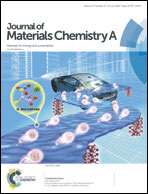An efficient hybrid adsorbent based on silica-supported amino penta-carboxylic acid for water purification†
Abstract
Amino poly-carboxylic acids (APCAs) offer unique binding properties as host molecules that can be tailored and potentially improved by incorporation into inorganic materials. Herein, we report the design and synthesis of a highly chelating and stable hybrid adsorbent based on silica-supported amino penta-carboxylic acid (SiDTPA) with a superior capability for water purification. The material was characterized using an appropriate set of spectroscopic and analytical techniques (EA, solid state 13C NMR, FTIR, TGA, SEM, STEM, XRD and BET surface area analysis) revealing a covalent organic framework and highly chelated mesoporous surface. Its adsorption studies highlight the influence of operating conditions, such as the contact time, initial concentration, pH, competitive extraction, temperature, thermodynamics and kinetics, on the adsorption of several potentially toxic metals from aqueous solutions and real water samples. The studies also reveal that the uptake of metal ions onto SiDTPA is a fast process, and reached its maximum within the first 20 min of contact time. The maximum sorption capacity of Cu2+, Zn2+, Cd2+ and Pb2+ was 2.40, 1.62, 0.85 and 0.3 mmol g−1, respectively. The adsorption process follows a pseudo-second-order kinetics and the positive values of ΔS° and ΔH° indicate the endothermic nature of the adsorption process, whereas a decrease of Gibbs free energy (ΔG°) with increasing temperature indicates the spontaneous nature of the adsorption process. Notably, the adsorbent can be regenerated continuously without affecting its extraction percentage. SiDTPA showed high effectiveness when compared to other described materials, and insights into the molecular-level phenomena governing this efficacy were provided by molecular dynamics (MD) simulations.



 Please wait while we load your content...
Please wait while we load your content...